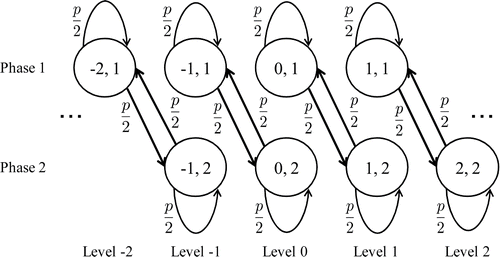Article title: “Subexponential Asymptotics of the Stationary Distributions of GI/G/1-Type Markov Chains”
Authors: Tatsuaki Kimura, Hiroyuki Masuyama, and Yutaka Takahashi
Journal: Stochastic Models
Bibliometrics: Volume 29, Issue 2, pages 190–239
DOI: 10.1080/15326349.2013.783286
The aim of this paper is to correct the minor errors of Propositions 2.4.1 and 2.4.2 of Kimura et al.[Citation4]
As in subsection 2.4 of Kimura et al.[Citation4], we consider a (possibly defective) MAdP with state space
and kernel
. For simplicity, we write (k1, j1) → (k2, j2) (respectively
) when there exists a path (respectively exist no paths) from state (k1, j1) to state (k2, j2) with some positive probability.
To define the period τ of the MAdP , we need the following conditions (see Assumption B.1 of Kimura et al.[Citation3]):
is irreducible (Assumption 1 (b) of Kimura et al.[Citation4]); and
for each
there exists some
such that (0, i) → (ki, i), or equivalently, ∑∞n = 1Ai, i*n(ki) > 0, where
denotes the n-fold convolution of
, i.e.,
and
for n ⩾ 2.
The conditions (A) and (B) are necessary for the propositions, lemmas, and theorems associated with the period τ, such as Propositions 2.4.1 and 2.4.2.
We now give an example in which the condition (B) does not hold whereas the conditions of Propositions 2.4.1 and 2.4.2 (i.e., Assumption 1 of Kimura et al.[Citation4]) are satisfied.
Example.
Let
and
Clearly,
is irreducible and strictly substochastic. It also follows from
for all
that
is irreducible and thus
is positive recurrent (see Proposition 2.2.2 of Kimura et al.[Citation4]), which shows that this example satisfies Assumption 1 of Kimura et al.[Citation4]. On the other hand,
if n1 ⩾ 2; or n3 ⩾ 2; or n1 + n3 ⩾ 2 and k = l. This fact implies that
for all
and
. In addition, we can readily prove (see Figure 1) that
Therefore,∑∞n = 1Ai, i*n(k) = 0 for all and
. As a result, the condition (B) is not satisfied and the period τ cannot be defined.
Probably, artificial settings such as the above example would not arise from typical queueing models (e.g. continuous-time BMAP/G/1, BMAP/PH/c queues and their variants). In other words, as far as we consider natural queueing models, the condition (B) would hold for resulting GI/G/1-type Markov chains. In addition, we can expect that the period τ (if it exists) is equal to one in many cases. From these reasons, it is assumed in the literature that τ exists and equals to one (see e.g. Bini et al.[Citation1] or Gail et al.[Citation2]).
Finally, we present a lemma, which provides a sufficient condition under which the condition (B) holds.
Lemma.
Suppose that and
are irreducible. If
is stochastic, then the condition (B) holds.
Proof.
We prove this lemma by contradiction. To this end, we assume that the negation of the condition (B), i.e., there exists some such that
Since
is an irreducible stochastic matrix,
which diverges to infinity. Therefore, for each pair of phases
, there exists some
such that (0, i) → (ki, j, j). Using this fact, we have the following path.
Combining equations (Equation1
) and (Equation2
) leads to
Furthermore, it follows from equations (Equation1
) and (Equation3
) that, for each
,
and thus
must be uniquely determined. Indeed, suppose that there exist some
and integer
such that
. We then have
Note here that equation (Equation3
) yields
, which is the contradiction to equation (Equation1
).
The above argument shows that, for each ,
which implies there exists some
such that
where [ · ]i denotes the ith element of the vector in square brackets.
We now note that for all k ⩽ −1. Thus, since
is stochastic,
From equations (Equation4
) and (Equation5
), we have
Equations (Equation4
) and (Equation6
) imply that level zero is not reachable from states {(k, i0); k ⩾ K}. Note here that the Markov chain
with transition probability matrix
follows the same law as the MAdP
while the former Markov chain is away from level zero. Thus, equations (Equation4
) and (Equation6
) are inconsistent with the irreducibility of
. Consequently, there exists no integer
such that equation (Equation1
) holds, i.e., the condition (B) is true.
The above lemma implies that the period τ is well-defined under Assumption 2 (I) of Kimura et al.[Citation4]. Thus, although the period τ is needed by the proofs of the lemmas and theorems in subsections 3.1 and 4.1, these results are true because they are proved under Assumption 2 (I). Similarly, Propositions 2.5.2 and 2.5.3 are true because the two propositions are proved under the conditions of the lemma presented above. On the other hand, the lemmas and theorems in subsections 3.2 and 4.2 are proved under Assumption 2 (II) of Kimura et al.[Citation4], independently of the period τ. As a result, for correctness, all we have to do is add the condition (B) to the conditions of Propositions 2.4.1 and 2.4.2.
References
- D. A. Bini; G. Latouche; B. Meini. Numerical Methods for Structured Markov Chains, Numerical Mathematics and Scientific Computation, Oxford University Press: New York, NY, 2005.
- H. R. Gail; S. L. Hantler; B. A. Taylor. Solutions of the basic matrix equation for M/G/1 and G/M/1 type Markov chains. Stochastic Models 1994, 10, 1–43.
- T. Kimura; K. Daikoku; H. Masuyama; Y. Takahashi. Light-tailed asymptotics of stationary tail probability vectors of Markov chains of M/G/1 type. Stochastic Models 2010, 26, 505–548.
- T. Kimura; H. Masuyama; Y. Takahashi. Subexponential asymptotics of the stationary distributions of GI/G/1-type Markov chains. Stochastic Models 2013, 29, 190–239.

